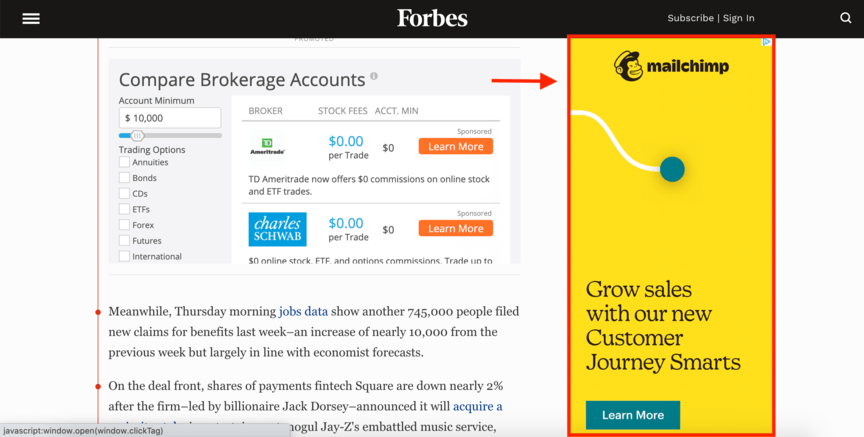-
 7 min. read
7 min. read
-
 Matthew Gibbons
Matthew Gibbons Lead Data & Tech Writer
Lead Data & Tech Writer
- Matthew is a marketing expert focusing on the SEO & martech spaces. He has written over 500 marketing guides and video scripts for the WebFX YouTube channel. When he’s not striving to put out some fresh blog posts and articles, he’s usually fueling his Tolkien obsession or working on miscellaneous creative projects.
What is an ad network?
An ad network is a platform that connects advertisers with publishers, allowing them to display ads on various websites and reach a wider audience.
Before the Internet, one of the most common ways for businesses to advertise was to put ads in newspapers. A local company would pay to display their ad, and the paper would carve out a space for it on one of their pages. Today, a similar process is occurring online, where you can pay a third-party website to display your ads on their site.
But the process is a bit different from it was with newspapers. To display your ads on other sites, you’ll most likely want to go through an ad network.
But what is an ad network, and how do ad networks work? We’ll answer both of those questions below, so read on to learn more.
Then consider partnering with WebFX’s team of over 500 experts for our online advertising services. Just call 888-601-5359 or contact us online to get started!
Learn how we increased traffic by over 40%, and conversions by over 100% for an ecommerce client.
Read the Case Study

What is an ad network?
An advertising network is essentially an online platform where businesses can buy ad space from third-party websites. It serves as a mediator between the two parties — advertisers go to it looking for someone to display their ads, and publishers go to it in search of revenue.
Ad networks can help match up interested advertisers and publishers, and they also facilitate the financial transactions that come with completed deals. Publishers come to networks looking to sell their ad space, and the networks then do the work of packaging and selling it. Before we move on, it can be helpful to distinguish ad networks from some other paid advertising terms you may encounter elsewhere.
Here are two terms to be familiar with when dealing with advertising networks:
- Demand-side platform (DSP): A DSP is similar to an ad network, but it only covers the advertiser’s side of things. It helps advertisers find publishers, but it isn’t of much benefit to publishers.
- Supply-side platform (SSP): An SSP is basically the opposite of a DSP — it helps publishers find viable advertisers.
In short, DSPs and SSPs are each one-sided, primarily helping only one party. Ad networks, on the other hand, provide a mediator through which the two parties can connect and interact directly with one another.
How do ad networks work?
Now that we’ve clarified the definition of the term, how do ad networks work? What does the process look like?
Read on to find out!
1. Finding a publisher
While the exact nature of the process varies from network to network, most tend to follow the same underlying procedure. It starts with publishers who are looking for advertisers willing to buy ad space from them. The publishers sign up with an ad network, which adds them to the network’s inventory.
Then it’s the advertisers’ turn. An advertiser approaches an ad network to find ad space, which they do by telling the network what they’re looking for in an outlet. They can provide preferences related to various ad features, including:
- Preferred budget
- Targeting options
- Ad frequency
- Ad format
- Pricing model
- And more!
After the advertisers have finished, the ad network will match them with publishers who fit their preferences.
2. Ad network types
It’s worth noting that different ad networks focus on different types of publishers, so verify that you’re working with your preferred type before you start plugging in information. The three main types of ad networks are:
- Premium ad networks: Premium ad networks focus on high-quality “premium” publishers that are well-known and have large, broad audiences.
- Vertical ad networks: Vertical networks limit themselves to particular industries, like auto or fashion.
- Specialized ad networks: Specialized networks focus on publishers that work only with a certain type of ad format. For example, one network might only offer access to publishers who use video ads.
Once they’ve received their results and had time to look over them, the advertisers can select a publisher and make a deal.
3. Running your ads
With the deal made, advertisers can then set up their ad campaigns through the network, which will run their ads on the publisher’s website. Most ad networks allow businesses the option of rotating different individual ads through their purchased ad space, allowing for some variety.

An important distinction to keep in mind when looking at different ad networks is what sorts of pricing models they have available. You could end up paying significantly different amounts of money depending on which model your publisher uses.
The most common models are:
- Cost per mille (CPM): With CPM, you pay for every 1000 impressions of your ad (the number of times the ad appears on someone’s screen).
- Cost per click (CPC): With CPC, you pay each time someone clicks on your ad.
- Cost per acquisition (CPA): With CPA, you pay for every conversion (or other specific user action) that your ad generates.
If you want to market through display ads on other websites, it’s in your best interest to go through an ad network. Keep reading to find out how ad networks can benefit you!
3 ad network benefits
Using an advertising network to manage your online ads carries quite a few advantages. Not only does it benefit publishers by helping them more easily find a source of revenue, but it’s also a huge boon to advertisers like your business.
Here are three major ad network benefits to consider!
1. Ad networks spare you tedious searches
One of the most compelling features that ad networks offer is that they aggregate publishers from across the Internet. By bringing so many available sites together in one place, they make it vastly easier for you to find outlets for displaying your ads. Under different circumstances, you would have to undergo the long and pedantic process of manually searching for third-party websites where you could advertise.
Ad networks, however, make that unnecessary.
2. Ad networks pair you with just the right sites
Not only do ad networks make it easier for you to find all the available publishers in one place, but they also help find just the right sites for you. Since you start by telling your network what your preferred ad format is, it can determine which publishers would be the best fit. For example, you might tell your ad network that you want to run ads at a particular budget and frequency.
In response, the network will match you with publishers who offer that arrangement.
3. Ad networks offer access to premium outlets
One of the most convenient ad network benefits is the fact that some networks provide access to premium publishing outlets. Though many networks focus on “remnant” — non-premium — inventory, you have the option of selecting one that focuses on picking out the most top-tier publishers. Though premium inventory is more expensive, it also grants you access to high-quality ad placement.
Some of the most well-known examples of premium publishing outlets include The New York Times or CNN, which are highly viewed and respected.
Learn how we increased traffic by over 40%, and conversions by over 100% for an ecommerce client.
Read the Case Study

WebFX can improve your online advertising strategy
If you’re still uncertain about the specifics or using an ad network, you can rest easy — WebFX is here to give you a hand! We know paid advertising inside and out, and our more than 1,100 testimonials prove that we leave our clients happy with their results. With our digital advertising services, you’ll get help working through every step of the process listed above, from managing your budget to selecting the right publishers.
You’ll also receive a dedicated account representative to keep you informed of everything we do for you. To get started with us, just give us a call at 888-601-5359 or contact us online today!
-
 Matthew is a marketing expert focusing on the SEO & martech spaces. He has written over 500 marketing guides and video scripts for the WebFX YouTube channel. When he’s not striving to put out some fresh blog posts and articles, he’s usually fueling his Tolkien obsession or working on miscellaneous creative projects.
Matthew is a marketing expert focusing on the SEO & martech spaces. He has written over 500 marketing guides and video scripts for the WebFX YouTube channel. When he’s not striving to put out some fresh blog posts and articles, he’s usually fueling his Tolkien obsession or working on miscellaneous creative projects. -

WebFX is a full-service marketing agency with 1,100+ client reviews and a 4.9-star rating on Clutch! Find out how our expert team and revenue-accelerating tech can drive results for you! Learn more
Try our free Marketing Calculator
Craft a tailored online marketing strategy! Utilize our free Internet marketing calculator for a custom plan based on your location, reach, timeframe, and budget.
Plan Your Marketing Budget

Maximize Your Marketing ROI
Claim your free eBook packed with proven strategies to boost your marketing efforts.
Get the GuideTry our free Marketing Calculator
Craft a tailored online marketing strategy! Utilize our free Internet marketing calculator for a custom plan based on your location, reach, timeframe, and budget.
Plan Your Marketing Budget





